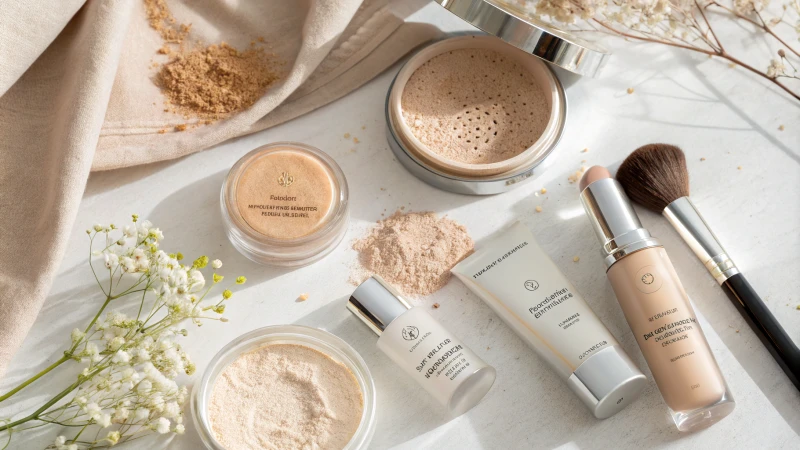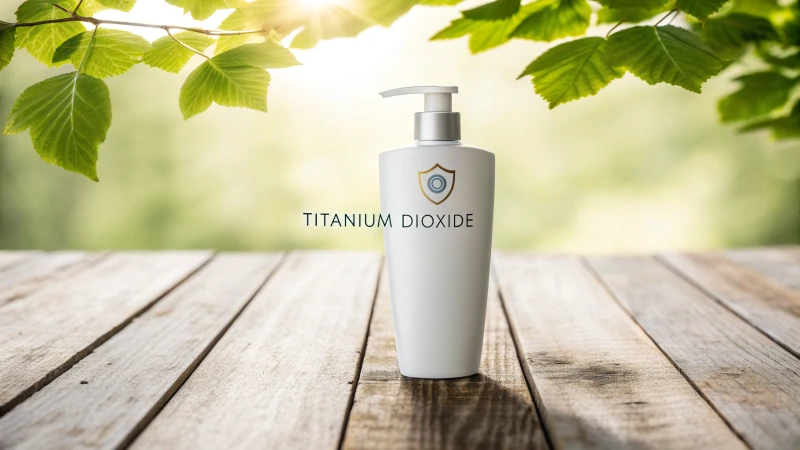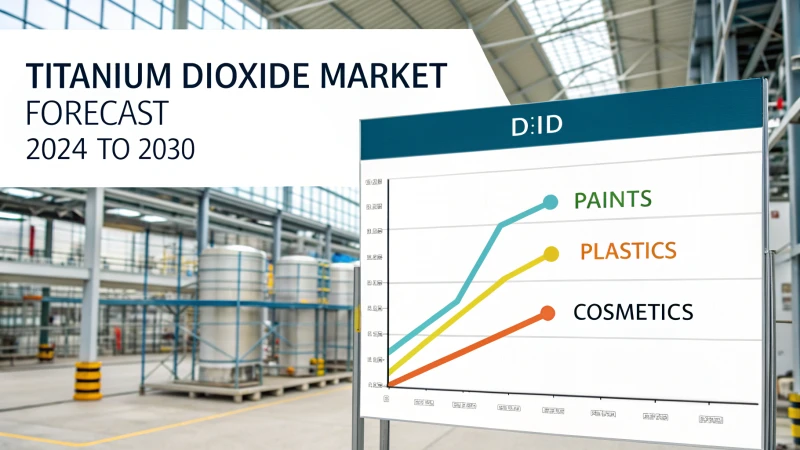
Interested in the safety of titanium dioxide in your makeup? I felt the same way when I began exploring beauty products.
Titanium dioxide (TiO2) is usually safe in cosmetics. People often use it directly on the skin. The FDA and EMA say it is not toxic. They emphasize this point. However, breathing in tiny nanoparticle forms causes worry for some individuals. It is really important to know both the benefits and risks of this compound. This knowledge helps you choose the right beauty products.
I felt fascinated and a bit cautious when I first found titanium dioxide. Many of my favorite foundations and sunscreens contain it. But is this ingredient truly safe? After researching, I learned titanium dioxide (TiO2) is usually seen as safe. It is especially safe in cosmetics used on the skin. Regulatory agencies like the FDA and EMA say it is non-toxic. However, some worry about inhaling its nanoparticles. Choosing beauty products wisely can greatly change with these insights. Understanding titanium dioxide’s benefits and risks guides my choices.
[claim claim=”Titanium dioxide is non-toxic when used in cosmetics.” istrue=”true” explanation=”Regulatory agencies like the FDA confirm that titanium dioxide is safe for topical use in cosmetics.”]
[claim claim=”Inhalation of titanium dioxide nanoparticles is a safety concern.” istrue=”true” explanation=”While titanium dioxide is safe topically, inhaling nanoparticles poses potential risks, raising safety concerns.”]
What are the Benefits of Titanium Dioxide in Makeup?
Ever wondered why your makeup works so well? Join me to explore the amazing benefits of titanium dioxide. This ingredient is more than just a fancy term. It’s really a game-changer for beauty lovers like us!
Titanium dioxide in makeup gives superb UV protection. It increases coverage and opacity. People know it is safe for skin use. It remains a very valuable part of cosmetics.

Provides Sun Protection
Sun protection helps shield our skin from harm. Titanium dioxide acts as a physical sunscreen, reflecting and scattering harmful UV rays. This makes it particularly beneficial in products like foundations and tinted moisturizers, where sun protection is essential.
Notably, TiO2 doesn’t break down under sunlight, ensuring prolonged protection throughout the day. I remember trying a foundation with titanium dioxide on a sunny day. My skin felt safe while looking great. It’s crucial to pick products with TiO2 for sunny days; we need that extra defense.
For more detailed information, check out the benefits of sun protection1.
Offers Coverage and Opacity
I always search for makeup that looks perfect without many layers. Titanium dioxide helps here like a superhero! In addition to sun protection, titanium dioxide provides excellent coverage and opacity in makeup formulations. This is why it is often found in foundations and powders.
| Makeup Product | Benefit of TiO2 |
|---|---|
| Foundations | Provides a smooth finish and hides imperfections |
| Powders | Offers matte appearance while controlling shine |
I remember trying a new powder with titanium dioxide. It gave a beautiful, matte finish. It hid my little imperfections. The ability to provide this kind of coverage helps consumers achieve a flawless look without needing multiple layers of product.
Explore more about makeup formulations2 to understand how different ingredients work together.
Non-Toxic and Safe for Skin
I’m really keen on safety with beauty products. I must know what I’m using on my skin. Titanium dioxide is generally recognized as safe by regulatory authorities like the FDA and EMA when used topically. Its non-irritating properties make it suitable for all skin types, including sensitive skin.
This safety profile comforts me when I use my favorite products. Knowing TiO2 is approved for cosmetics and some foods reassures me of safe choices.
Learn more about safe cosmetic ingredients3 for a better understanding of what you put on your skin.
Stability in Formulation
Have you used a product that lost its effect during the day? Titanium dioxide solves that! Another significant benefit of titanium dioxide is its stability in cosmetic formulations. Unlike some chemical sunscreens that may degrade over time or become less effective, TiO2 maintains its efficacy when exposed to sunlight.
Understanding ingredients like TiO2 helps me pick reliable products that perform well no matter how long my day is. This quality ensures that products containing titanium dioxide provide consistent performance, making it a preferred choice among cosmetic formulators.
For insights into cosmetic formulation chemistry4, visit our resource page.
[claim claim=”Titanium dioxide provides effective sun protection in makeup.” istrue=”true” explanation=”It reflects and scatters UV rays, ensuring reliable sun safety in products.”]
[claim claim=”Titanium dioxide is harmful to sensitive skin types.” istrue=”false” explanation=”This ingredient is recognized as safe and non-irritating for all skin types.”]
How Does Titanium Dioxide Compare to Other Sunscreen Ingredients?
Do you ever think about how titanium dioxide compares to other sunscreen ingredients like zinc oxide and chemical filters? Let’s explore this and discover more!
**Titanium dioxide is a popular ingredient in mineral sunscreens. Many people like it because it protects well against UV light and is safe for the skin. It usually blocks UVB rays, so it’s key for those wanting to guard their skin. Understanding this helped me realize the importance of choosing the right ingredient for my skin’s health.
Titanium Dioxide vs. Zinc Oxide
Titanium dioxide and zinc oxide are well-known in mineral sunscreens. They protect the skin. Here is how they differ꞉
When I found out that titanium dioxide mainly blocks UVB rays, I was unsure. How do I pick the best one for me? Zinc oxide is good if you need broad coverage, especially for UVA rays. But titanium dioxide feels lighter on the skin. I love its feel, especially in makeup. It feels like an extra layer but not heavy.
Safety and Regulatory Perspectives
Both ingredients are approved by groups like the FDA and EMA for use in cosmetics. I learned that how the ingredient is made is vital. Tiny particles of titanium dioxide might be risky if inhaled. But applied on skin, like in sunscreens or makeup, the risks are low. It’s nice to know titanium dioxide is mostly safe when used right. It’s non-toxic.
Effectiveness Over Time
I like that titanium dioxide stays stable in sunlight. Some chemical sunscreens lose strength when facing UV rays. But titanium dioxide remains strong for longer periods outdoors. This means less worry about reapplying. I feel relieved knowing my sun block stays strong while I enjoy the sun.
Environmental Considerations
I think a lot about how my choices affect the planet. Titanium dioxide and zinc oxide are seen as better for the environment. Unlike some chemical sunscreens, they are less harmful to sea life, like coral reefs. Choosing safe sunscreen ingredients feels more important now. It’s like I am helping the ocean and caring for my skin.
Conclusion꞉ A Balance of Benefits
Both titanium dioxide and zinc oxide provide excellent sun protection. They differ in UV protection, skin feel, safety and impact on the environment. This information helps me choose wisely. For lightweight or full coverage, knowing these facts helps me choose products that fit my needs. Skin protection is just as vital as caring for the environment.**

My Experience with Titanium Dioxide Sunscreen
I remember the first time I chose a sunscreen with titanium dioxide. After a beach trip, my skin felt too sun-kissed. I wanted something better for my next adventure. Titanium dioxide grabbed my attention because it is known for broad-spectrum protection. Many praised it, but was it truly effective? Let’s explore this together!
| Feature | My Experience |
|---|---|
| Skin Feel | Light and non-greasy |
| Effectiveness | Good against UVB |
| Overall Satisfaction | Positive |
TiO2 is primarily effective against UVB rays, while zinc oxide is renowned for its superior UVA protection. For users concerned about comprehensive UV coverage, zinc oxide may be the preferable choice. However, titanium dioxide offers a lighter feel on the skin, making it a popular option in cosmetic formulations. For further insights, check out Zinc Oxide Sunscreens5 for more detailed comparisons.
Safety and Regulatory Perspectives
Both titanium dioxide and zinc oxide are approved by regulatory bodies like the FDA and EMA for use in cosmetics and sunscreens. However, the safety profile can vary depending on the form of the ingredient used. For instance, concerns have been raised regarding the inhalation of nanoparticle forms of TiO2. In contrast, zinc oxide is generally considered safe in all forms for topical use.
Effectiveness Over Time
Titanium dioxide’s stability under sunlight is a significant advantage. It does not degrade or lose efficacy when exposed to UV rays, unlike some chemical sunscreens that may require reapplication more frequently. This aspect makes titanium dioxide an appealing choice for prolonged outdoor activities. To explore more about the longevity of sunscreen effectiveness, visit Sunscreen Longevity6.
Environmental Considerations
As consumers become increasingly environmentally conscious, the impact of sunscreen ingredients on marine life has come into focus. Both titanium dioxide and zinc oxide are considered to be more environmentally friendly compared to chemical sunscreens, which can contain harmful ingredients that contribute to coral bleaching. Understanding the ecological implications of sunscreen ingredients is crucial for informed choices; learn more at Sunscreen Environmental Impact7.
Conclusion: A Balance of Benefits
While both titanium dioxide and zinc oxide offer excellent sun protection, their differences in effectiveness against UV rays, skin feel, safety profiles, and environmental impact guide users in making informed choices about their sunscreen options. Each ingredient has unique properties that cater to varying skin types and preferences, allowing consumers to select products that best meet their needs.
[claim claim=”Titanium dioxide primarily protects against UVA rays.” istrue=”false” explanation=”Titanium dioxide is effective against UVB rays, not primarily UVA, unlike zinc oxide which offers superior UVA protection.”]
[claim claim=”Both titanium dioxide and zinc oxide are environmentally friendly.” istrue=”true” explanation=”Both ingredients are considered more eco-friendly than chemical sunscreens, reducing coral bleaching risks and being safer for marine life.”]
What Are the Concerns Surrounding Nanoparticle Titanium Dioxide?
Do you ever think about the tiny particles in your makeup? I often do! Titanium dioxide nanoparticles are very popular these days. However, they bring many worries. What dangers do we really face when we use these products?
**Concerns about titanium dioxide nanoparticles involve possible health risks from breathing them in, environmental effects from runoff and different safety regulations in various areas. Staying informed and careful is very important about how these nanoparticles affect us and our planet both in daily life and in manufacturing. Let’s look deeper into these topics!
Health Risks of Titanium Dioxide Nanoparticles
Discovering the health risks of TiO2 nanoparticles was very striking to me. I love how they improve beauty products, but I also need to think about the dangers. Breathing them in is a big worry. Research shows inhaling TiO2 can really cause breathing problems and lung inflammation. This is especially true for workers handling TiO2 in powder form. It’s scary to know people are exposed to this every single day.
Skin exposure is another issue. It’s disturbing to imagine these nanoparticles might very well go through our skin layers. They could harm our skin cells. Although research is not yet conclusive, it truly makes me wonder about the long-term effects of frequent use. If interested, you may read deeper health studies through scientific articles.
Environmental Concerns
The environment matters to me and what TiO2 nanoparticles do to it worries me a lot. These particles can quickly enter ecosystems through waste or runoff. It’s really sad to think they could harm aquatic creatures or climb the food chain.
Here’s a glimpse of the situation꞉
For more on environmental impacts, check environmental research.
Regulatory Perspectives
Knowing product safety regulations is crucial. I am amazed by how different these rules can be! The European Union has limits on using it in some products due to safety worries. They point to possible cancer risks when inhaled. However, across the ocean, the U.S. Food and Drug Administration (FDA) says TiO2 is typically safe for skin use. This difference causes much confusion.
It’s important for us as consumers, as well as for manufacturers, to stay informed. Check out more on regulations at current regulations.
Conclusion
After learning all this, it’s clear that titanium dioxide nanoparticles are common in many products. We should really be careful using them. Their possible risks to people and the environment need attention and ongoing investigations. Being informed and alert helps us make smart choices for our health and the planet’s future.**

Health Risks of Titanium Dioxide
I have worked in the cosmetic industry for many years. I have seen titanium dioxide (TiO2) do wonders. This ingredient provides our foundations and sunscreens with impressive coverage. It also protects against UV rays. However, deeper research worries me about its effects on my skin. I also worry about inhaling it during production.
Nanoparticle titanium dioxide (TiO2) has raised several health concerns, particularly regarding its inhalation and dermal exposure. Studies indicate that when inhaled, TiO2 can lead to respiratory issues and potential lung inflammation. This is particularly pertinent for workers in industries using TiO2 in powdered form.
In terms of dermal exposure, some research suggests that nanoparticles can penetrate skin layers, leading to cytotoxic effects on skin cells. However, the data on skin absorption remains inconclusive, prompting ongoing research into this area. For a detailed look at related health studies, check out scientific articles8.
Environmental Concerns
The environmental implications of TiO2 nanoparticles are also significant. These particles can enter ecosystems through waste disposal and runoff from manufacturing processes. They may pose a risk to aquatic life by disrupting ecosystems and potentially entering the food chain.
A table summarizing the potential environmental impacts includes:
| Impact Category | Description | Potential Effects |
|---|---|---|
| Aquatic Toxicity | TiO2 accumulation in water bodies | Harm to fish and aquatic organisms |
| Soil Contamination | Runoff leading to soil deposition | Affect soil microorganisms |
| Bioaccumulation | Uptake by organisms in the food chain | Risk to predators and humans |
For an in-depth examination of environmental studies, refer to environmental research9.
Regulatory Perspectives
Regulatory bodies have varied stances on titanium dioxide nanoparticles. The European Union has moved to restrict its use in specific applications due to safety concerns, citing potential carcinogenic risks when inhaled. Conversely, the U.S. Food and Drug Administration (FDA) maintains that TiO2 is generally safe for topical use.
Understanding these regulatory differences is crucial for consumers and manufacturers alike. For more on regulatory frameworks, explore current regulations10.
Conclusion
Let us explore this topic together as although titanium dioxide nanoparticles are widely used and generally considered safe, their potential risks to human health and the environment warrant careful consideration and further research. Continued monitoring and assessment are essential for ensuring safety in both cosmetic applications and industrial uses.
[claim claim=”Inhalation of titanium dioxide nanoparticles can cause lung inflammation.” istrue=”true” explanation=”Studies show that inhaling TiO2 can lead to respiratory issues, including lung inflammation, particularly for workers exposed to powdered forms.”]
[claim claim=”Titanium dioxide nanoparticles are safe for all skin applications.” istrue=”false” explanation=”While the FDA deems TiO2 safe for topical use, some research suggests potential cytotoxic effects from dermal exposure, indicating a need for caution.”]
What Are the Best Alternatives to Titanium Dioxide in Cosmetics?
I have entered the world of cosmetics and noticed more people feel uneasy about titanium dioxide. Many products exist, but are there options that offer similar benefits without possible dangers?
Certainly! Alternatives to titanium dioxide exist in cosmetics. Zinc oxide provides strong UV protection. It feels gentle on sensitive skin. Mica gives a lovely shimmer. Mica does not offer sun protection.

Understanding the Need for Alternatives
My experience in the beauty industry reveals concerns about titanium dioxide in cosmetics. People talk more about safety now. So, formulators, like me, search for options giving good results without safety worries. This search is not just for rules; it is about listening to a community asking for clear information and more care for our skin.
Natural Alternatives
-
Zinc Oxide
I felt amazed when I first found zinc oxide as an option. It protects well, acting as a physical sunscreen similar to titanium dioxide. Plus, it soothes irritated skin. This makes it great for sensitive skin types like mine.- Benefits: No irritation, broad UV protection, friendly to sensitive skin.
- Considerations: Sometimes, a white layer stays on the skin, which may not suit everyone.
Learn more about zinc oxide in cosmetics11.
-
Mica
Everyone loves a bit of sparkle! Mica is perfect for adding a bright glow to makeup, although it doesn’t protect from the sun. Its light-reflecting nature delivers a beautiful finish to enhance any look.- Benefits: Adds shimmer and depth to makeup products.
- Considerations: Lacks sun protection, so pair with UV filters for sunny days.
Explore mica’s role in beauty products12.
Synthetic Alternatives
-
Octinoxate
Octinoxate impressed me with its light touch on the skin. It works well against UV rays. Many people prefer its lighter feel compared to other sunscreens.- Benefits: Lightweight sensation, effective against UVB.
- Considerations: Some might find it irritating; its approval status is also under review.
Read more about octinoxate13.
-
Ethylhexyl Methoxycinnamate
Also called octyl methoxycinnamate, this staple ingredient provides strong UVB defense. I appreciate its smooth blending in formulations and stable nature.- Benefits: Excellent stability and mixes well with other ingredients.
- Considerations: It does not protect against UVA; mix it with other filters for full sun safety.
Discover more about this ingredient14.
Formulating with Alternatives
While testing these alternatives in my products, I see that it’s not only about replacements for titanium dioxide; it is really about crafting products that feel nice and work well on the skin. Merging the right texture and protective qualities raises a product from basic to very special.
| Ingredient | Type | UV Protection | Skin Benefits | Considerations |
|---|---|---|---|---|
| Zinc Oxide | Physical | Broad-spectrum | Anti-inflammatory | Can leave a white cast |
| Mica | Natural | None | Adds shimmer | No UV protection |
| Octinoxate | Synthetic | UVB | Lightweight | Skin irritation risk |
| Ethylhexyl Methoxycinnamate | Synthetic | UVB | Good stability | UVA protection needed |
This journey of alternatives is enlightening and rewarding; it leads to safer cosmetic products while meeting our strong wish for honesty and eco-friendliness in beauty.
[claim claim=”Zinc oxide is a safe alternative to titanium dioxide in cosmetics.” istrue=”true” explanation=”Zinc oxide offers broad-spectrum UV protection and is non-irritating, making it suitable for sensitive skin types, unlike titanium dioxide which raises safety concerns.”]
[claim claim=”Mica provides UV protection similar to titanium dioxide.” istrue=”false” explanation=”Mica enhances cosmetic appearance with shimmer but does not offer UV protection, unlike titanium dioxide or zinc oxide.”]
Conclusion
Titanium dioxide is safe for skin use in cosmetics but poses inhalation risks as nanoparticles. Alternatives like zinc oxide offer similar benefits without safety concerns.
-
Discover how titanium dioxide enhances makeup performance while ensuring safety for your skin. ↩
-
Learn how makeup formulations leverage titanium dioxide for better coverage and stability. ↩
-
Find out more about safe ingredients in cosmetics, including titanium dioxide’s role. ↩
-
Understand the chemistry behind cosmetic formulations and why titanium dioxide is a key ingredient. ↩
-
This link provides comprehensive insights into zinc oxide’s effectiveness as a sunscreen ingredient, essential for understanding its benefits compared to titanium dioxide. ↩
-
Learn about the longevity of different sunscreens and what that means for your skin protection during outdoor activities. ↩
-
Discover how various sunscreen ingredients affect marine ecosystems and why choosing the right product matters for environmental health. ↩
-
Explore recent studies on TiO2 nanoparticles to understand their health implications better. ↩
-
Learn about the environmental effects of titanium dioxide nanoparticles on ecosystems. ↩
-
Understand the varying regulations regarding titanium dioxide in different regions. ↩
-
This link provides insights into natural substitutes for titanium dioxide, enhancing your understanding of safer ingredients in cosmetics. ↩
-
Gain a deeper understanding of mica’s usage in cosmetic formulations by exploring this link. ↩
-
Explore the role of octinoxate as a synthetic alternative and its benefits in cosmetic formulations. ↩
-
Learn more about ethylhexyl methoxycinnamate and how it serves as a substitute for titanium dioxide. ↩





